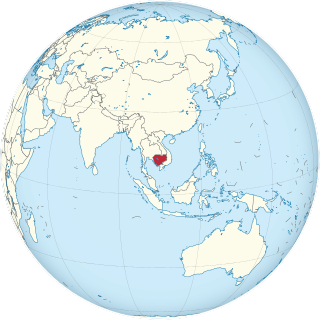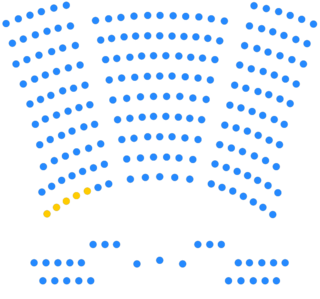
Cambodia is a country in mainland Southeast Asia. It borders Thailand, Laos, Vietnam, the Gulf of Thailand and covers a total area of approximately 181,035 km2 (69,898 sq mi). The country is situated in its entirety inside the tropical Indomalayan realm and the Indochina Time zone (ICT).

Cambodia, officially the Kingdom of Cambodia, is a country in Mainland Southeast Asia, spanning an area of 181,035 square kilometres, bordered by Thailand to the northwest, Laos to the north, Vietnam to the east, and the Gulf of Thailand to the southwest. The capital and most populous city is Phnom Penh.

The French protectorate of Cambodia refers to the Kingdom of Cambodia when it was a French protectorate within French Indochina, a collection of Southeast Asian protectorates within the French colonial empire. The protectorate was established in 1863 when the Cambodian King Norodom requested the establishment of a French protectorate over his country, meanwhile Siam renounced suzerainty over Cambodia and officially recognised the French protectorate on Cambodia.

Banteay Meanchey is a province of Cambodia located in the far northwest. It borders the provinces of Oddar Meanchey to the north, Siem Reap to the east, Battambang to the south, and shares an international border with Thailand to the west. Its capital and largest city is Serei Saophoan.

Kratié, alternatively spelled Kracheh, is a province of Cambodia located in the northeast. It borders Stung Treng to the north, Mondulkiri to the east, Kampong Thom and Kampong Cham to the west, and Tboung Khmum, and the country of Vietnam to the south.

Cambodia is divided into 25 provinces. The capital Phnom Penh is not a province but an "autonomous municipality", equivalent to a province governmentally and administered at the same level as the other 24 provinces.

Norodom Chakrapong is a Cambodian politician, businessman and former major-general of the Royal Cambodian Armed Forces. He is the fourth son of Norodom Sihanouk of Cambodia and also a half-brother of the current king, Norodom Sihamoni. Chakrapong started his career as a military pilot in 1963. After Sihanouk was overthrown in 1970, Chakrapong spent time under house arrest, then in Beijing as the Head of Protocol of then-Prince Sihanouk, afterwards living overseas before he joined the Funcinpec in 1981 and fought against Vietnamese occupation as a commander of the Armée Nationale Sihanoukiste. In 1991, Chakrapong left Funcinpec to join the Cambodian People's Party (CPP) and served as the Deputy Prime Minister of Cambodia between 1992 and 1993. When the CPP lost the 1993 general elections, Chakrapong led a secession attempt in 1993. In 1994, he was accused of joining a failed coup attempt which led him to be sent into exile. After Chakrapong was pardoned in 1998, he founded a private airline company, Royal Phnom Penh Airways. The airlines later stopped all operations in early 2006.

The Cambodian–Vietnamese War was an armed conflict between Democratic Kampuchea, controlled by Pol Pot's Khmer Rouge, and the Socialist Republic of Vietnam. The war began with repeated attacks by the Liberation Army of Kampuchea on the southwestern border of Vietnam, particularly the Ba Chúc massacre which resulted in the deaths of over 3,000 Vietnamese civilians. On 23 December 1978, 10 out of 19 divisions of Khmer Rouge's military divisions opened fire along the shared Southwestern borderline with Vietnam with the goal of invading the Vietnamese provinces of Đồng Tháp, An Giang and Kiên Giang. On 25 December 1978, Vietnam launched a full-scale invasion of Kampuchea, and subsequently occupied the country in 2 weeks and removed the government of the Communist Party of Kampuchea from power. In doing so, Vietnam put an ultimate stop to the Cambodian Genocide, during which 25% of the Cambodian population had already been executed under Pol Pot’s regime.

UTC+07:00 is an identifier for a time offset from UTC of +07:00. In ISO 8601 the associated time would be written as 2024-04-17T07:18:33+07:00. It is 7 hours ahead of UTC, meaning that when the time in UTC areas is midnight (00:00), the time in UTC+07:00 areas would be 7:00 in the morning.

The Royal Cambodian Armed Forces is Cambodia's national military force. The Supreme Commander-in-Chief is King Norodom Sihamoni. Since 2018, General Vong Pisen has been the Commander-in-Chief of the RCAF as head of the Army, Navy, Air Force and the Gendarmerie. The armed forces operate under the jurisdiction of the Ministry of National Defence. Under the country's constitution, the RCAF is charged with protecting the sovereignty and territorial integrity of the Kingdom of Cambodia.

The Khmer National Armed Forces were the official armed defense forces of the Khmer Republic, a short-lived state that existed from 1970 to 1975, known today as Cambodia. The FANK was the successor of the Royal Khmer Armed Forces (FARK) which had been responsible for the defense of the previous Kingdom of Cambodia since its independence in 1953 from France.

The National Assembly is one of the two houses (chambers) of the Parliament of Cambodia. It is referred to as the lower house, with the Senate being referred to as the upper house.

The People's Republic of Kampuchea (PRK) was a partially recognised state in Southeast Asia which existed from 1979 to 1989. It was a client state of Vietnam, founded in Cambodia by the Vietnamese-backed Kampuchean United Front for National Salvation, a group of Cambodian communists who were dissatisfied with the Khmer Rouge due to its oppressive rule and defected from it after the overthrow of Democratic Kampuchea, Pol Pot's government. Brought about by an invasion from Vietnam, which routed the Khmer Rouge armies, it had Vietnam and the Soviet Union as its main allies.

The Royal Cambodian Army is a part of the Royal Cambodian Armed Forces. It has ground forces which numbered 85,000 divided into eleven divisions of infantry, with integrated armour and artillery support. The Royal Army is under the jurisdiction of the Ministry of National Defence.
Administrative divisions of the Kingdom of Cambodia have several levels. Cambodia is divided into 24 provinces and the special administrative unit and capital of Phnom Penh. Though a different administrative unit, Phnom Penh is at provincial level, so de facto Cambodia has 25 provinces and municipalities.

The following outline is provided as an overview of and topical guide to Cambodia:
Cambodia does not recognize same-sex marriage or civil unions, but does recognize a registry program known as the "declaration of family relationship" offering limited legal rights to same-sex couples. As of June 2021, the registry has been introduced to 68 communes. Same-sex marriage has received support from King Norodom Sihamoni and his late father, King Norodom Sihanouk.

Preah Sihanouk, also Sihanoukville, is a province (khaet) in southwest Cambodia on the Gulf of Thailand. The provincial capital, also called Sihanoukville, is a deep water port city and a steadily growing and diversifying urban center on an elevated peninsula.

General elections were held in Cambodia between 23 and 28 May 1993. The result was a hung parliament with the FUNCINPEC Party being the largest party with 58 seats. Voter turnout was 89.56%. The elections were conducted by the United Nations Transitional Authority in Cambodia (UNTAC), which also maintained peacekeeping troops in Cambodia throughout the election and the period after it.

Khmer nationalism is a form of nationalism found in Cambodia, that asserts that Khmers (Cambodians) are a nation and promotes the cultural unity of the Khmer (Cambodian) race.
















